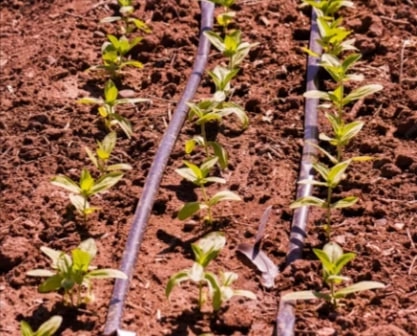
In an era where efficient usage of water is a priority in irrigation, many irrigation techniques concentrated on saving water while efficiently providing it are emerging and becoming popular.
Among those irrigation systems, drip irrigation is at the top, and to further make the drip system efficient, several techniques and methods have been introduced.
One of them is using tape instead of pipes in drip irrigation. This post explores everything you need to know about drip tape irrigation systems, from basic principles to advanced implementation strategies.
What Is Drip Tape Irrigation?
Drip tape is the thin-walled drip tube. Technically, it comes in various shapes, which we’ll talk about later.
Because of the thin wall, you can carry it easily by folding or rolling it. It only comes to life when it starts to irrigate.
Drip tape comes with precisely placed emitters that provide targeted, controlled water delivery, maximizing efficiency while minimizing waste.
For flexibility, the system consists of polyethylene tape, ensuring water reaches the root zone where plants need it most, reducing evaporation and runoff while maintaining optimal soil moisture levels.
How Drip Tape Irrigation Works?
As I mentioned earlier, drip tape comes to life when it is irrigated. Water flows through the main supply line into distribution headers, which then feed individual drip tape lines laid alongside crop rows.
Each emitter in the tape is designed to release water at a specific flow rate, typically measured in gallons per hour per emitter.
The system operates at low pressure, typically 8 to 15 PSI, though it can go as low as 4 PSI, making it energy-efficient and suitable for areas with limited water pressure.
Water moves through the tape via turbulent flow paths within each emitter, ensuring consistent water distribution even across long tape runs.
Drip tapes can last up to 7 years if covered and 2–5 years on the surface.
Types of Drip Tapes
There are several types of drip tape based on water delivery and shapes to help you select the appropriate option for specific crops and growing seasons.
Turbulent Flow Drip Tape
This type of drip tape has emitters with labyrinth-style flow paths that create turbulence, helping to prevent clogging and ensure consistent flow rates.
It is ideal for applications where water quality may vary or where long tape runs are necessary.
Pressure Compensating Drip Tape
This is the premium option, adjusting the flow rate automatically to maintain consistency across varying pressures and elevations.
Pressure-compensating tape is ideal for fields with significant elevation changes or irregular topography.
Laminar Flow Drip Tape
Laminar flow tape uses a smooth flow path to deliver water and is also a cost-effective solution.
However, it is more susceptible to clogging and best suited for clean water applications and shorter tape runs.
Subsurface Drip Tape
Subsurface drip tape is designed for permanent and semi-permanent installation below ground level, providing excellent water efficiency and reducing evaporation.
At the same time, it keeps the soil surface dry for easier cultivation and weed control.
Benefits of Drip Tape Irrigation
You can consider the same advantages of drip irrigation for drip tape irrigation. It is not just limited to water savings, but offers comprehensive benefits for modern agriculture operations.
Water Conservation and Efficiency
Drip irrigation has water efficiency of 80% to 95%, compared to sprinklers and flood irrigation at under 70%.
This dramatic improvement comes from targeted water delivery that minimizes evaporation, runoff, and deep percolation losses.
You’ll typically see a 20–50% reduction in water usage when switching from conventional irrigation methods to drip tape. This conservation becomes increasingly valuable as water resources become scarcer and more expensive.
Reduced Diseased Pressure
By maintaining controlled soil moisture levels, drip tape irrigation significantly reduces the incidence of fungal diseases and other moisture-related plant health issues.
This reduction often translates to decreased pesticide use and lower production costs.
Enhanced Crop Yield and Quality
Consistent and targeted water flow provided by drip tape irrigation creates optimal growing conditions that often result in increased yields and improved crop quality.
Plants experience less stress from water fluctuations, leading to more uniform growth and development.
Precise water control also allows for better nutrient management through fertigation, further enhancing crop performance.
Weed Control Benefits
Targeted irrigation only waters plant roots, leaving the areas between rows dry, significantly reducing weed formation.
This leads to decreased herbicide use and less cultivation.
Labor and Energy Savings
Once the drip tape system is installed, there is no need for constant manual operation.
Automated timers and controllers can manage irrigation schedules, freeing farm workers for other essential tasks.
The low-pressure operation also reduces energy costs compared to high-pressure sprinkler systems.
List of Best Drip Tapes
Toro Aqua-Traxx Drip Tape
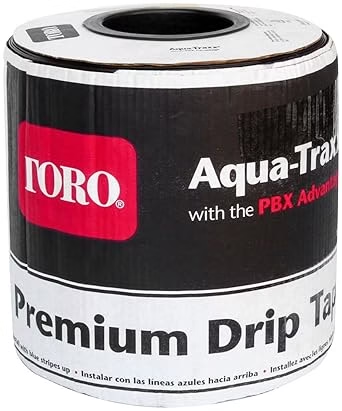
Toro Aqua is a highly clog-resistant tape due to multiple inlet filters and a best-in-class coefficient of variation (CVs) below 3%.
The tape is 8mil thick, with a 5/8″ diameter, and can handle up to 15 PSI. Flow rate: 1.00 GPM/100′. Length: 2,000 feet.
Emitter spacing options range from 4 to 24 inches at no added cost, offering precise placement and flexibility.
With a wide variety of flow rates, wall thicknesses, and diameters, it suits many applications. The PBX advantage increases durability, clog resistance, and uniformity, setting Aqua-Traxx apart from ordinary drip tapes.
Nalwart Drip Tape
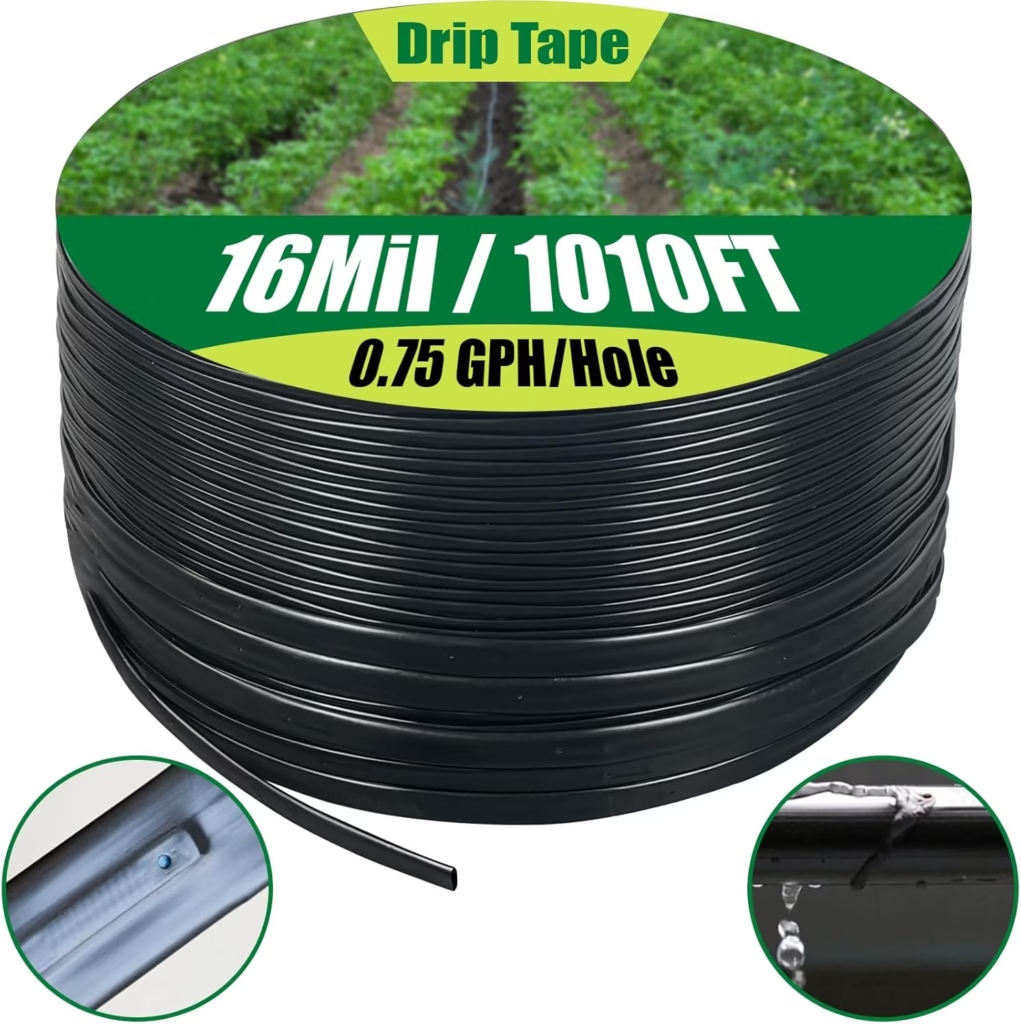
This 5/8″ Drip Tape, having 1010FT length and 6″ spacing roll, is designed for precise watering.
Made from the PE material giving you long term durability and the UV-resistant, can withstand prolonged exposure to the sun without degradation. It is also designed to handle mechanical stress, ensuring it remains in excellent condition even in challenging weather conditions.
Nalwart tape, 16mil thick having the 1010FT length and 6″ spacing roll, is designed for precise watering. Each hole in the tape emits a consistent 0.75 GPH (Gallons Per Hour).
The installation is made easy With its injection-molded drippers, it provides high resistance to clogging and long-term, consistent water distribution. Say goodbye to uneven watering and enjoy healthy plant growth.
Treela Drip Tape
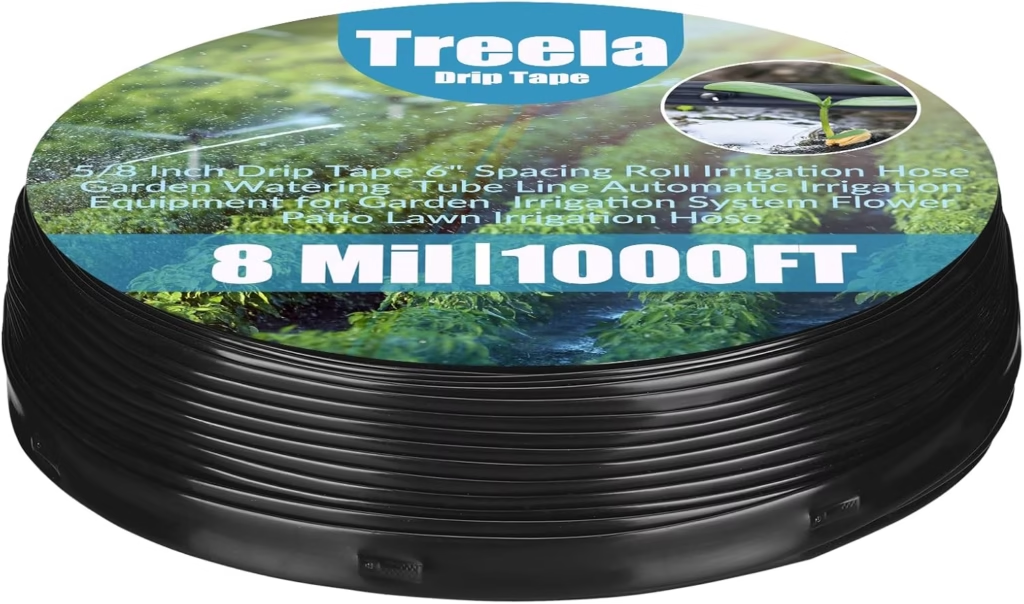
Treela Drip Tape is designed for underground and above-ground installation, made of quality PE material resistant to UV and mechanical stress, with nice compression performance, and suitable for long-term exposure to the sun.
The pack comes with 5/8 inch drip tape, 6″ spacing, 1000′ roll, 8 mil thick irrigation hose.
Drip tape is made of injection-molded drippers, which have a high resistance to clogging and long-term uniform water distribution.
Also, drip tape welded to the inner wall can minimize friction loss, and the inner wall of the drip belt is smooth with no particles.
Bandelt Drip Tape Kit
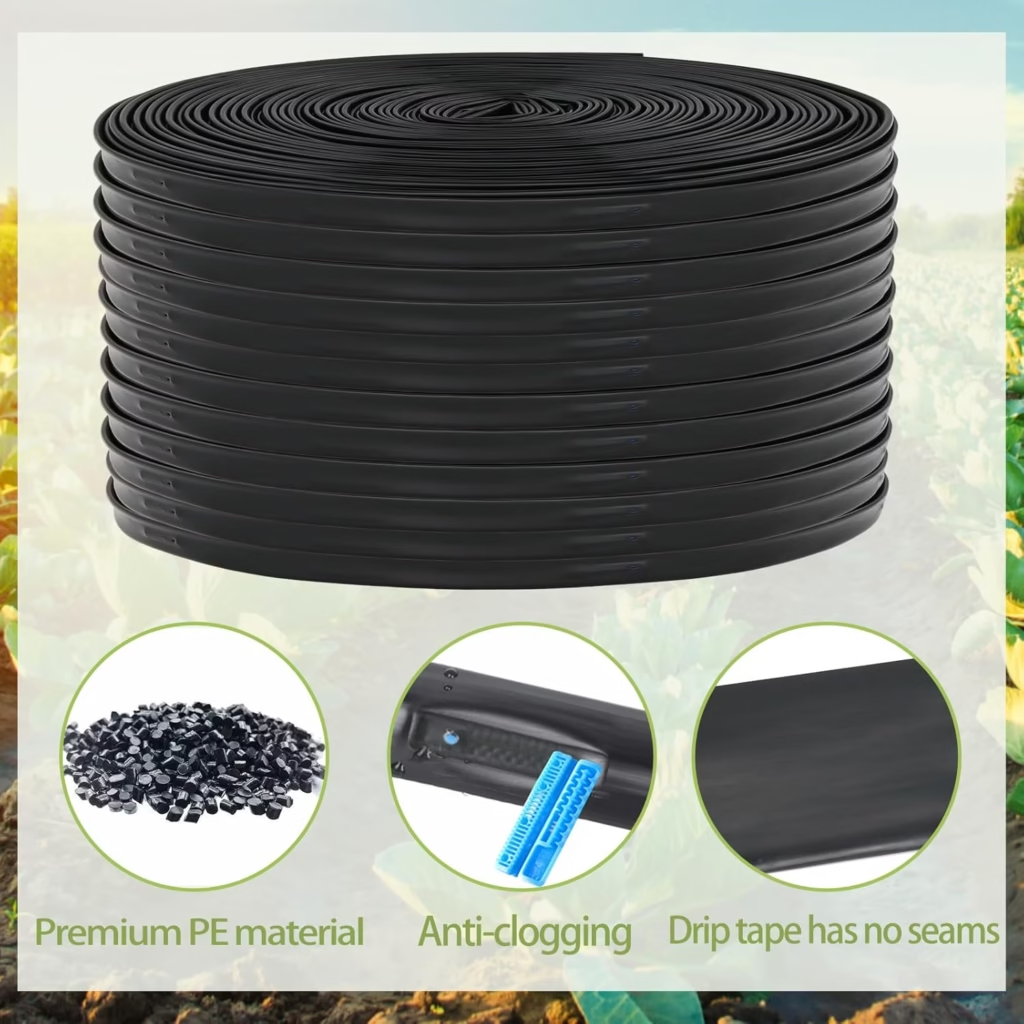
Bandelt is a relatively new Drip Tape Kit considered to be another on the list. Bandelt offers you a comprehensive solution for irrigation, you don’t have to buy extra fittings to install.
The kit includes 1640 ft 5/8” irrigation tape (Wall Thickness: 15 mil, Emitter Flow: 0.79 GPH), 50 pcs 1/4″ barb drip tape connectors, 50 pcs drip tape row ends, 5 pcs drip irrigation elbows, 5 pcs drip irrigation 3-way tees, and 20 pcs irrigation couplings.
The 1/4″ (6 mm) barb connector on drip tape fittings is designed to fit approximately 5/8″ drip tape, providing a steady 30 PSI inlet pressure to ensure reliable water flow, no more worrying about low pressure or uneven water distribution.
The drip tape row end, which fits 5/8″ drip tape, is a practical and useful addition for your irrigation system. It can make tape pressure regulated, ensure a safe fit to prevent leaks, is convenient to use, and provides effective garden drip tape irrigation.
Drip tape is made of UV-resistant PE material that can withstand sunlight exposure and harsh weather conditions. The drip irrigation hose without seams ensures a more reliable and even installation, and long-term use will not damage it.
Dark Tank Drip Tape
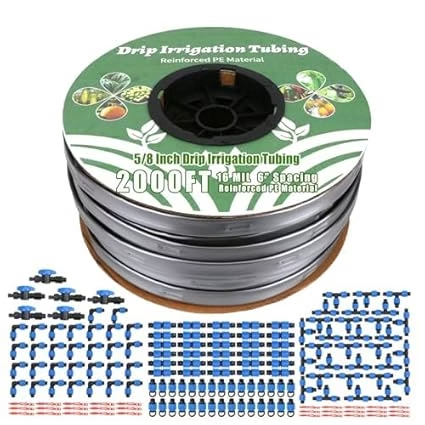
This is another drip tape that also comes with drip kits, including 156 irrigation accessories.
Drip tape is made of PE material and includes a 2000 ft 5/8 inch irrigation pipe with a distance of 6 inches between each drip emitter to achieve effective irrigation coverage. It also includes 30 tape end plugs, 30 drip tape couplers, 30 drip irrigation 3-way tees, 30 drip irrigation elbows, 30 flow restrictor clips, and 6 tubing coupling valves.
This kit helps you with easy installation without glue or fixtures. You just need to firmly push the pipes onto the hooks, which ensures a tight fit and prevents leaks.
The tape is colored light, which prevents sunlight absorption and lasts longer. It also has a repellent effect on birds and pests, effectively protecting against bird pecks and insect bites.
Final Thoughts…
Drip tape irrigation solves many problems facing modern agriculture. Through superior water efficiency, improved crop yields, and reduced environmental impact, these systems offer compelling benefits for farmers seeking sustainable and profitable operations.
The initial investment in drip tape irrigation typically pays for itself within 2–4 years through water savings, yield improvements, and reduced operating costs.
Plus, careful planning, proper installation, and consistent maintenance will lead to success. Implementing these systems correctly often reveals that the benefits extend far beyond simple water savings to include improved crop quality, reduced disease pressure, and enhanced operational efficiency.

Leave a Reply